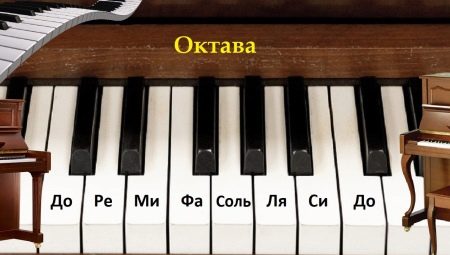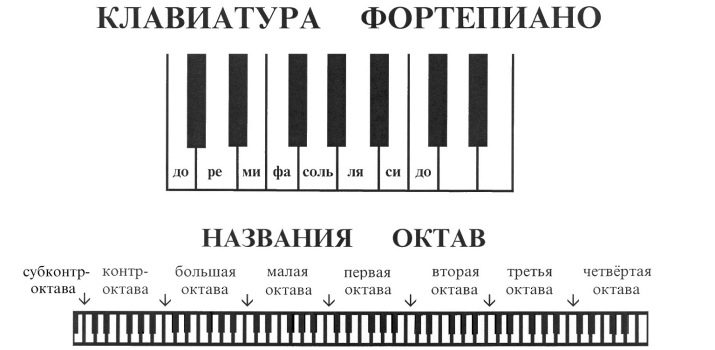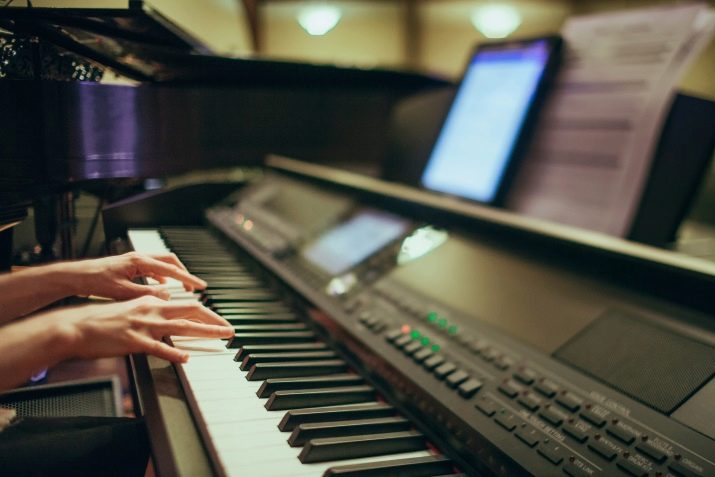Octaves on the piano

Anyone who starts learning the piano is faced with the concept of octaves. Their knowledge helps to navigate the keyboard, and also eliminates mistakes in mastering the works. Therefore, it is worth considering what octaves are, how many of them are on the piano and in what sequence they are presented.

What it is?
Translated into Russian, the octave means "eighth" or "8". This corresponds to the number of keys between notes with the same name. Besides, the concept of an octave is a set of keys that are in this interval.

To make it easier to find notes on a piano keyboard, there is a division into white and black keys. Moreover, the latter alternate in groups of 2 and 3. The beginning of the octave is the white key located to the left of the two black keys, and the ending is the white key to the right of the group of three black keys. As a result, each full octave contains 7 white and 5 black keys.
Despite the identity of the composition, the octaves differ in pitch and spelling of notes. To the left of the performer are the keys that produce low sounds, and to the right are the upper register of the instrument.

The number of octaves differs depending on the instrument. On an acoustic or electronic piano, on a synthesizer with 60 keys there are 5. More or fewer keys of electronic analogs will directly affect the number of octaves.

Octave names and locations
A surprise for a beginner is the fact that the numbering of piano octaves starts from the middle. And this is true for a piano that has a full keyboard, and for a synthesizer, which has only 5 octaves.

So, the first octave is usually between the music stand and the performer. This arrangement has several rationales:
- the sounds produced by the keys of the first octave are more often found in the range of the human voice;
- the training of musicians usually begins with these notes;
- these keys are used more often in music than notes located at the edges of the keyboard.

If you follow the octave scheme on the piano to the right, then the first is followed by the second, third, fourth. The fifth octave, represented by the C note, is not available on all pianos and grand pianos. Instruments with fewer keys may have a second or third key on the far right.

For writing notes, the treble clef is mainly used here. Moreover, the first octave is written up to the third line of the staff. The second ends above the first additional ruler. The third begins with a do, located on the second additional ruler.
For the rest of the octaves, a special sign is often used, meaning the transfer of music an octave or two up. This eliminates confusion about the number of additional rulers.

If you move from the center of the instrument to the left, then the octave arrangement will be in the following sequence:
- small;
- large;
- counter octave;
- subcontroctave.
The keyboard actually begins with the last one. However, it contains only 3 keys, so it is also incomplete.

A bass clef is designed for notes below the first octave. Moreover, the small octave is located above the second ruler, on which the B of the large octave is written. The writing line is below the second lower extension ruler. To write the rest of the notes, an additional sign can also be used, prescribing the transfer of notes one octave lower.

In the minor and first octaves, there are notes that have variants of spelling in the treble and bass clef. For example, C can be recorded on both the lower extension ruler in the treble clef and the upper extension bass line. This implies the same key, which should be taken into account when analyzing the works. The difference in writing is necessary for a more holistic melody writing. Thus, a piece of music for the left hand will, if possible, be recorded in the bass clef, and for the right hand - in the treble clef. There are exceptions, though.
The designation of each keyboard is closely related to the staff, where each key is identified with a note. Therefore, in order to navigate the keyboards well, you need to learn musical notation well.

How to play?
When learning to play the piano, the simplest melodies are in one octave. This allows you to quickly become familiar with frequently used keys. Then the mastering of the instrument proceeds according to the principle of gradual expansion of the range - first to the right, and then to the left.

Teachers are advised not to dwell on one octave for a long time in order to exclude the formation of stereotypes among students that prevent them from developing the art of playing. You can go outside the limited world in the following ways.
- Execution of scales. Students in the lower grades perform a scale of two octaves, in the senior grades the range of the scale expands to four. In addition to mastering finger fingering and technique, it helps the student to feel free, working with registers located at a distance from him. Moreover, you need to gradually switch from C major to other keys in order to stimulate the work with black keys.
- Introduction to the repertoire of works that are based on the comparison of the sound of individual sounds or melody in different octaves. On the one hand, such pieces are not so difficult to master, since the child logically understands that the same material is repeated at different heights, while maintaining a similar arrangement of keys and fingering. On the other hand, he sees in the musical text that the notes located in different octaves are written in different ways. In the future, this will help him quickly navigate where exactly the text written on paper is performed on the keyboard.

In addition to whites, blacks are also beginning to be studied. This process is associated with the development of the signs of sharp, flat and bekar. The first one makes the sound higher, the second one makes the sound lower. Moreover, these actions are not always associated with transitions to the black key. Bekar is required to cancel the sign.
The prefix "double" before the name of the sign indicates that the decrease or decrease occurs in double size.
The mastering of octave etudes becomes a separate stage of training. To do this, you need to have a sufficiently developed hand so that your fingers can reach the desired keys without much tension. Since the distance spanning 8 notes is quite large, it is taken with the outermost fingers (1 and 5).

The size of the hand of high school students also allows the substitution of the fifth finger for the fourth, which becomes necessary in the development of complex pieces and studies. So, if the melody in the piece is recorded with an octave doubling, then in the upper voice smooth transitions from sound to sound are expected. Therefore, fingering involves alternately picking intervals 1-4 and 1-5 with your fingers. The use of the fourth finger in the octave is necessary if it falls on the black key. In this case, the fifth finger would be undesirable.
Errors
The practice of learning to play the piano knows cases when children confused octaves, and also experienced difficulties with reproducing notes. This often happens when there are mistakes on the part of the teacher.
- Acquaintance begins immediately with the keyboard. As a result, the child begins to extract sounds without understanding the structure of the piano and the specifics of its work. The result is difficulties in mastering the keyboard, and in the future, difficulties in finding the necessary sound production.

You can prevent the consequences by devoting the first lesson to a general acquaintance with the instrument and its parts. What matters is a visual demonstration of the way the sound appears, as well as the factors affecting its volume, pitch and other parameters.
- Learning begins with a specific note. If the student has not received a complete understanding of the keyboard before, then the first learned key will become for him a kind of reference point from which he will build everything else. The result will be a distorted view of the keyboard space, where, depending on the circumstances, each note can become the main one.

A more effective methodology assumes a path from the general to the particular. First, registers are mastered as the largest structural elements. This is followed by division into octaves, zones formed between the black keys, and at the last stage, the notes are called. This method will speed up the development of the keyboard, as well as relieve the fear of playing in extreme registers.
- Using one note as the starting point makes it difficult to find the rest of the keys. After all, if each sound is counted from "to", it will take more time than knowing the system as a whole. You can identify the problem by asking the student to name the notes in reverse order. Or by asking him to find the desired key without counting from the start. If the child began to get confused, this means that he did not remember the real arrangement of the notes, which in the future will complicate the selection of melodies by ear, as well as reading from sight.
The way out of the situation is the emphasis on imaginative thinking, which allows you to make each note individual, to come up with your own unique image.

- In an effort to reinforce the mastery of black keys, some teachers are in no rush to give children plays with black keys. As a result, a pathological fear is formed, which prevents the study of pieces in keys other than C major. In addition, the constant use of white keys leads to distortion of the position of the hand. The fingers gradually move towards the edge, which leads to the lowering of the wrists.

The way out of the situation is the transition to black keys, as soon as the student gets used to white. Accessing more keys from the start leads to a more harmonious development of the performer.
Getting started with black keys in a timely manner eliminates another mistake common to musicians. It is expressed in the formed belief that when a sharp or flat appears, it is imperative to press the black key. In fact, raising the E and B notes by a semitone causes the adjacent white key to be pressed. A similar result gives a decrease in fa and to.

Confusion in octaves is often common among students who buy a synthesizer for home use. While this seems to be a practical solution for modest living conditions, it has several weaknesses.
- A child accustomed to practicing in five octaves is at a loss in front of a full piano keyboard. As a result, the learned song can sound higher or lower than the required octave. It is important for these students to establish a connection between different keyboards.
The standard will be the first octave, located strictly in the middle of any instrument.
- Many electronic instruments are not sensitive to key pressure. Therefore, the opportunity to work on dynamics and strokes is lost. This can only be solved by intensive work in the classroom on an acoustic instrument.

To summarize: knowledge of the structure and arrangement of octaves is an indispensable part of the education of everyone who masters a musical instrument. This helps you quickly become familiar with the variety of keys, and also opens the way to sight-reading, listening, improvisation and other possibilities.









